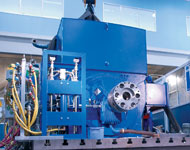
High temperature superconducting technology for all-electric ship propulsion.
Researchers from Siemens Corporate Technology, together with colleagues from the Siemens I&S Marine Solutions and A&D Large Drives divisions, have developed a new type of propulsion motor for all-electric ships (AES). The synchronous machine is part of an electric propulsion system based on high temperature superconducting technology (HTS). The HTS engine generates four megawatts of power at a torque of over 300 kN.m.

HTS technology offers numerous advantages for modern shipbuilding. The superconductors of the rotor windings carry a current density 100 times greater than that in conventional copper windings. As a result, significant weight and volume reductions are possible. In addition, there are no electrical losses with HTS, so that means greater efficiency. The enclosed, self-regulating system, which cools the superconducting rotor windings of the motor to a temperature of 27K, promises cheaper cooling with low maintenance. HTS motors therefore create totally new flexibility in ship design and the layout of the systems on board. As a result, it is possible to design more energy-efficient ships with more effective capacity utilisation that have less environmental impact and are cheaper to operate.
With the development of the world's first HTS generator rated at four megawatts, Siemens made a considerable contribution to the all-electric ship with superconductors. The generator, which has been successfully tested by Siemens at its Nuremberg system test centre, is now enhanced by another new development from Siemens, the HTS propulsion motor. With 30 times higher torque compared with the generator, the HTS motor is also considerably smaller, lighter, and more efficient than a conventional electric propeller motor. The first HTS motor is currently under construction. In 2009, the developers plan to run an intensive test programme on the machine on a test bed for large-scale propulsion units.
The new propulsion motor represents a further milestone in the development of HTS technology for use in all electric ships. Cruise ships or mega-yachts already make use of the advantages of electric propulsion. The trend is also apparent in naval vessels, with first ships already at the planning stage. The all-electric concept is useful in ships with a strongly fluctuating energy requirement. Luxury liners tend to cross the seas at a leisurely pace, making calls at a large number of ports and putting in the occasional sprint in between. They therefore need a variable form of propulsion power. The power requirement for on-board catering and accommodation is also not constant. However, the electrical power generated with HTS generators can be distributed flexibly throughout the ship according to requirements. Passengers also profit from HTS technology. Electrically propelled ships are inherently quieter than their diesel counterparts and the superconductors reduce vibrations and engine noise even further.
The propulsion unit was developed in a cooperative venture between the Siemens Industrial Solution and Services (I&S) Marine Solutions, Automation and Drives (A&D) Large Drives divisions, and Siemens Corporate Technology. The HTS wire comes from European High Temperature Superconductor KG (EHTS), Hanau, one of the world's leading manufacturers and developers of superconductors. Three partners TransMIT Gesellschaft für Technologietransfer, ThyssenKrupp Marine Systems/Blohm + Voss and Schiffbau-Versuchsanstalt Potsdam are also backing the project, which is being co-funded by the German Federal Ministry for Economics and Technology.
For more information contact Jose Machado, Siemens Southern Africa, 0860 80 80 80, +27 (0)11 652 2149, [email protected], www.siemens.co.za

© Technews Publishing (Pty) Ltd | All Rights Reserved